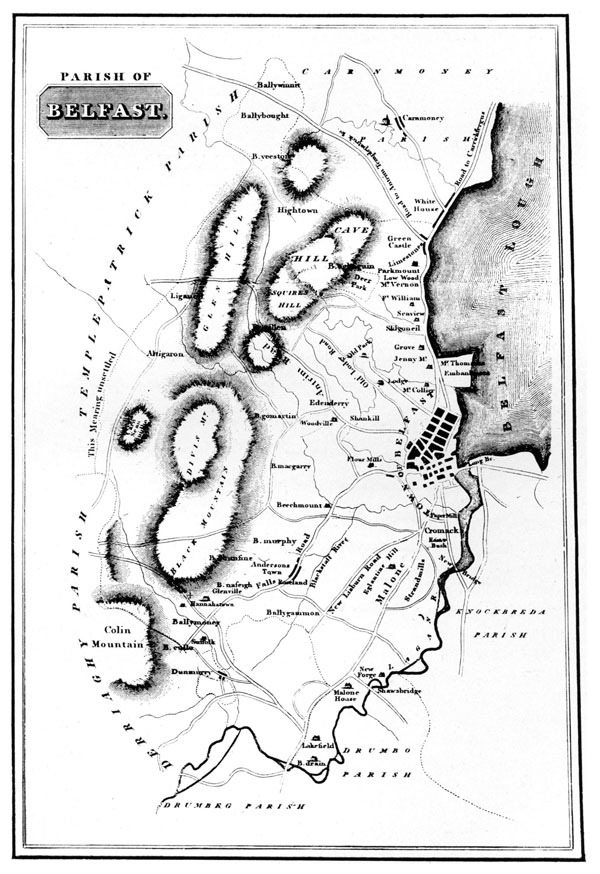THE SECOND CONGREGATION.
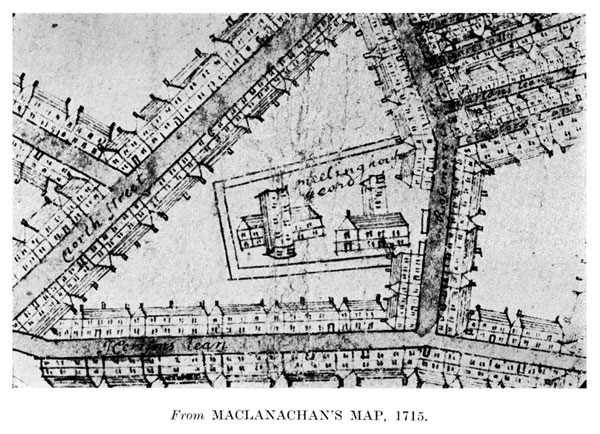
Since the publication of History of the Second Congregation of Protestant Dissenters in Belfast, I have had an opportunity of examining carefully "The mapp of Belfast, as survey'd, anno 1715, by John maclanachan ", purchased by the Linen Hall Library and Society for Promoting Knowledge, at an auction in Sotheby's, London, 9th June, 1898, Among the many interesting and informative particulars recorded on the map is "meeting house yeard", situated on the north side of "Rosemary lean" and to the east of "Herison's lean", i.e., " Harrison's Lane, alias Hercules Street, alias Royal Avenue.
A crude sketch of the two Meeting-houses is given thereon, from which we can form an idea of the structure of the two earliest Meeting-houses in Belfast. A graphic description of the older building has been given by my respected friend, the late Rev. Alexander Gordon, M.A.:
"Here are we in Rosemary Street, by help of our good McBride. On this pleasant spot of ground he planted us, when it was an open field, abutting upon a crooked lane, with the scent of Rosemary still about it, and leading to the backs of houses in another lane, which bore originally, it is believed, the name of Ardglass, later dignified into the mythological title of Hercules;... Here, on the green sward of the meadow, an oblong structure arose. An excrescence to the west gave it the shape of a T ; but there were outside stairs to the three galleries, which varied the configuration of its exterior; and at the north-east corner, there was a small session-house, stuck on to the main building. In the south-west angle of the field, a minister's dwelling was put up for the worthy McBride."
Historic Memorials, p.18.
There are no existing records of the formation of the building of 1708, when the Second Congregation was erected, * except the plan on the 1767 lease, up to which date both the First and the Second Congregations were mere tenants at will. The Second Meeting-house, like the First, had three Galleries with outside stairs leading thereto, and the entrance to the ground floor seems to have been on the west side, where there is no indication of outside stairs.
* The word " erection" was used, at the period, for the formation of a number of people into one body, such as a congregation; whereas in modern times the word is applied to something raised up, such as a building.
The Minister's house, marked A on the plan, was the residence of the Rev, James Bryson, M.A., for close upon twenty years; but, on his retirement in 1791, the house ceased to be used as a Manse and was let out for various uses, until it was finally disposed of about 1870. Before the building was removed, Mr. John Ritchie, Honorary Secretary, had a photograph taken of the building which was then occupied by K. Henney, 27 Rosemary Street and J. Johnston at 29, next door, both given in the Business Directory of Belfast, 1865, as Boot and Shoemakers. A pen and ink drawing of the Manse has been executed by Mr. John Knox Vinycomb, Architect, son of my old friend, John Vinycomb, M.R.L.A., which is here reproduced, together with the photograph from which the drawing was made.
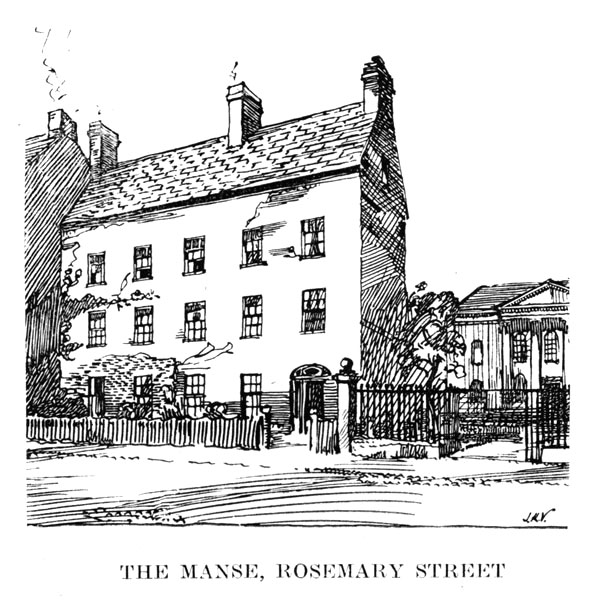
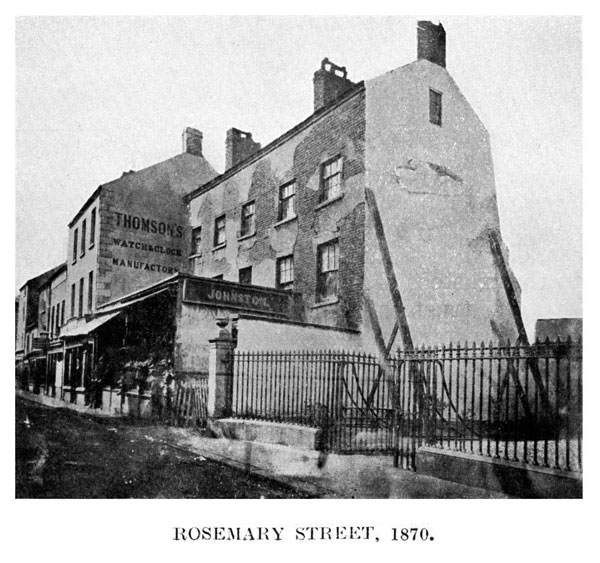
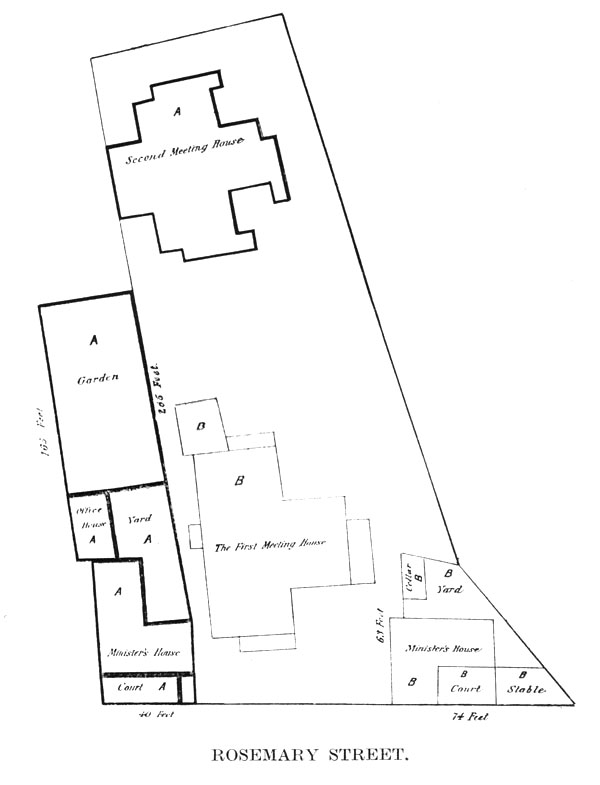
By lease, dated 31st August, 1767, the premises marked B were conveyed to the trustees of the First Congregation and the premises marked A to the trustees of the Second Congregation, while the remainder of the ground was held in common by the two Congregations, The lease was in perpetuity, subject to the payment of twenty shillings of the then currency by the trustees of each Congregation. The Irish Toleration Act (6 Geo. 1, c. 5) had been in operation since 1719, and the only restriction in the lease was that each of the two Meeting-houses was to be used "for the public worship of Almighty God and for no other intent and purpose whatsoever."
COMMUNION SERVICE.
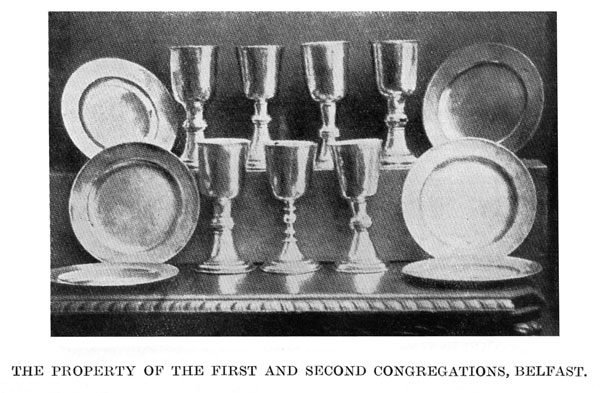
History of the Second Congregation of Protestant Dissenters in Belfast contained the statement that the Communion Service, of which there was the above illustration, was "the Property of the First and Second Congregations, Belfast," The book was carefully and critically reviewed by the Rev. Alexander Gordon, M.A., in The Christian Life of 26th January, 1901, over the well-known initials of"A.G." ; and no exception was taken to the statement as to the joint ownership, nor, so far as I am aware, was any doubt expressed as to the accuracy of my statement.
When the old congregation of Belfast decided to divide the congregation into two, in accordance with the Rev. John McBride's letter of 16th June, 1706, stating that if there be 3,000 persons in the Belfast Congregation, the Session of Belfast (i.e., the Committee of the First) desired on 2nd March, 1708, "that Mr. Kirkpatrick might be ascertained to the new meeting-house then built and Mr. McBride to the old meeting-house and the dwelling-house then built for him."
On the following day, 2nd March, 1708, an agreement was subscribed by Edward Brice, Isaac Macartney, and R Lennox on the one part (as representing the old congregation, now the First) and William Crawford and Dr. Ferguson on the other part (as representing the new congregation, now the Second). The particulars of that agreement were :-- "That the Stipend, being £160 p. annum, should be equally divided between the two Minrs., and the dwelling-house now built should be reserv'd for Mr, McBride; that the Congregation should be divided into two but no steps, at this time, to be made for dividing before applying in an orderly way to the Presby. in Aprile; that the old Meeting-house should be then ascertain'd, viz., on 3rd March to Mr. McBride and the new to Mr. Kilpatrick."
The application received the consent of the Presbytery and the General Synod, at Antrim, on 1st June, 1708, "considering many weighty reasons for dividing the numerous congregation of Belfast, do hereby divide the same into two Congregations & appoint Mr. McBride & his Congregation to meet for public worship in the old Meeting-house & Mr. James Kirkpatrick, with his Congregation, to meet in the new; and that Mr. Kirkpatrick shall henceforth preach in the new Meeting-house; that the Stipend shall be collected in common & paid in equal portions to the two Minrs.; and that the Poor's Money shall be kept all together and distributed as formerly till the Committee, to be appointed, meet; and that Mr. McBride shall enjoy the dwelling-house now built."
No mention is made in the Minutes of General Synod of Ulster of the Communion Service which, at the time of separation, consisted of four silver cups and six pewter patens. On one cup was inscribed "THE GIFT OF JAMES STEWART TO THE MEETING HOUSE OF BELFAST, 1693"; on another "DONUM THO(MAE) CRAFORD COETUI PRESBYTER (IANO) DE, BELFAST, 1698"; and on a third, "JAMES MARTIN"'; while the fourth had neither inscription nor date, The fact that the four silver cups and the six pewter patens were not mentioned in the agreement of 3rd March, 1708, in which the "dwelling-house now built" was expressly reserved for Mr. McBride, is strong, but not conclusive evidence that the Communion Service was to remain the joint property of the two portions of the old congregation, meeting for worship in two separate buildings under different ministers. The Rev. Alexander Gordon sums up correctly the position :
"The two congregations were, for a time, practically one. Even when they agreed to be distinct, the stipend of £136 13s. 4d. continued to be collected in common and was equally divided."
Historic Memorials, p. 22.
An incident occurred in 1722 which throws considerable light on the ownership of the Communion Service. At the annual meeting of Synod, held at Londonderry, 26th June, 1722, "Mr. Saml. Smith, Commissioner from the new erection at Belfast, moved that their Petition for their proporcon of the comon stock belonging to the other Congrs., and of the cloaks, Palls, Flagons, and cups &c, may now be considered."
Mr. Smith evidently regarded the "Flagons & cups" as joint property or "comon Stock", of the First and Second Congregations, as there was none other in Belfast ; and we may safely assume that Smith was in a position to know, as he had been a member of the old congregation prior to 1708 and was commissioned to go to Glasgow to induce Mr. McBride to return to Belfast, in which mission he was successful. He continued a member of the old (First) Congregation till 1721, when the new (Third) Congregation was erected by the Presbytery. So far as the "cloaks" and "Palls" were concerned, Smith was correct in saying they were "comon stock." The Rev, Alexander Gordon says :
"These funeral trappings were originally the property of the First Congregation and afterwards the joint property of the First and Second Congregations and were lent on hire."
Historic Memorials, p. 64.
The Funeral Register is further described by Mr. Gordon :--
"This book was begun on 10 June, 1712 but the page containing the first entries is lost. It contains 171 pages of funeral entries (the last being dated 19th December, 1736) and 57 pages of accounts connected with them."
Ibid, p. 64.
The Rev. William Bruce, D.D., minister of the First Presbyterian Congregation from 1790 to 1841, wrote a series of articles entitled The Progress of Non-Subscription which appeared in The Christian Moderator, and in No. IX, dated January, 1827, he says :
"The original congregation was possessed of palls and mourning cloaks, intended at first, no doubt, for the accommodation of their own members; but afterwards hired out so as to bring in an income of £50 per annum and upwards. These also were to be used in common, and under a joint management."
The Christian Moderator, vol. I, p. 311.
George Benn in History of Belfast (1877), says :
"This book belonged to the First and Second Congregations jointly, and contains the records of the funeral proceedings of both for the era which it covers. It seems, however, to have been always more identified with the First Congregation, as being the more important, and probably that in which it originated. The book was well known to Dr. Bruce, and was highly valued by him. He wrote a general account of it and a description of its contents in the Christian Moderator, London, 1827; Vol. I, p. 311."
At the end of Historic Memorials there appears Annals of the Congregation in which, page 111, there appears : "1712, 27th Aug. Three silver cups brought from Dublin (Funeral Register)."
The Funeral Register contains a statement of much more importance and of greater significance than what appears on page 111 of Historic Memorials. At the top of page 219 of the Funeral Register there are the words: "Thomas Swendill Dr to Cash received ant" [anent] "of Cloakes and Mar Cloaths since the first day that I took them in Custitey being the 10th day of June, 1712."
Below that heading and on the same page there appears the sum of £27 14s. 0d, for the hiring of Cloakes, On the opposite page (220) there appears :
"Per Contra is Creditor"
"1712. Aug. 27. Cah pd Charles Kamage for Bringing 3 Silver Cups from Dublin 2/6d."
There thus appears in a joint book an entry of three silver cups, presumably Sacramental vessels, having been brought from Dublin and the carriage on same was paid out of joint money, which shows clearly that the First Congregation had no sole proprietary right to those three cups.
Further, the fact that the three silver cups from Dublin were treated and regarded as joint, although remaining in the custody of the First Congregation, as the "parent hive", is additional proof that the four silver cups belonging exclusively to the old congregation became joint property in 1708, But the proprietary right is removed beyond all doubt by the following statement of the Rev. William Bruce, D.D., while he was still minister of the First Congregation :
"Thus far the minutes of Synod. It was further agreed that the Sacramental Plate called cups and Flagons should remain a joint property in the custody of the old congregation to be used by both; and so it continues to-day a memorial of this amicable settlement and a pledge of the cordial fellowship and communion which have subsisted ever since between the ministers and people of these societies, worshipping in houses nearly contiguous, held by one Iease ; mutually attending the services both ordinary and sacramental in each, and occasionally possessing pews in both."
The Christian Moderator, Vol. I, p. 311.
Not only did Dr. Bruce, with his well-known gift of historical research, make a public pronouncement of the joint proprietary rights of the two Congregations, but, shortly before his death, handed the seven Silver Communion Cups to the Committee of the First Church as the property of the two Congregations. On that understanding they were received, as appears in the Minutes of the Congregational Committee. The Rev. Alexander Gordon, who had free access to those Minutes during the preparation of Historic Memorials, not only refrained therein from claiming a sole proprietary right, but, when reviewing, at considerable length, The History of the Second Congregation of Protestant Dissenters in Belfast, took no exception to the statement therein contained, "The property of the First and Second Congregations, Belfast" which appeared underneath a photographic reproduction of the seven Silver Cups and six Pewter Patens.
For over two centuries the Second Congregation used the Sacramental plate at their Communion Service, held twice each year, and, during that period, four generations of the Millin family reverently handled those Silver Cups. At the bi-centenary celebration of the erection of the Second Congregation, held in the Rosemary Hall, October, 1908, the Silver Cups were displayed in a prominent position as joint property. After the introduction of the individual cups, the old Silver Cups were placed upon the Communion Table in sacred memory of those who had "crossed the bar". And to-day, two hundred and thirty years after the separation of the First and Second Congregations, they are still, in the words of the Rev. Dr. Bruce, "a joint property in the custody of the old congregation."
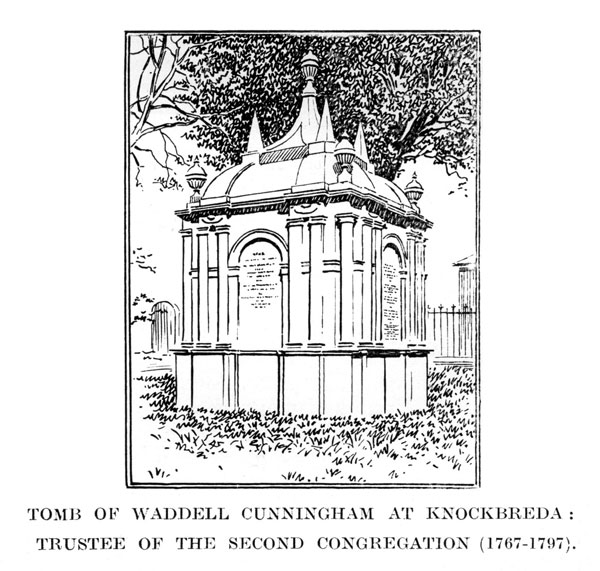
ALMS DISHES.
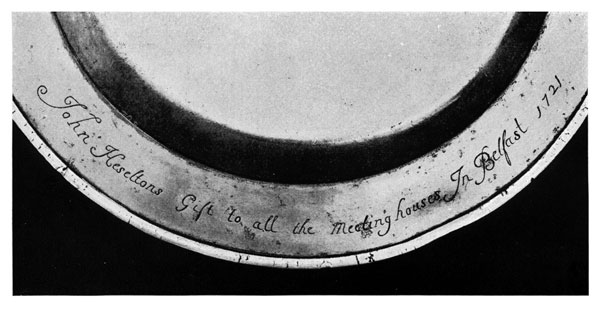
Two Alms Dishes, bearing the inscription, John Heseltons Gift to all the the Meeting houses In Belfast 1721 are at present in the custody of the First Congregation. Who this particular John Heselton was is not mentioned in Historic Memorials, but on page 77, under the heading Funeral Register, there is the following entry : "1721. Epr (April) 8 John Haselton, Elder, pr his wife," which indicates that the "mourning cloaks" were hired to the wife of John Haselton, Elder, for his funeral on 8th April, 1721. From that information we may regard the Alms Dishes with the above inscription as either a donatio mortis causa or as a bequest to "all the Meeting houses in Belfast" at the time of his death, April, 1721.
The Rev. A. Gordon says :
"1721. August. The Presbytery erected a third congregation in Belfast.The erection was confirmed by the Committee of Synod at Dungannon in October, and by the General Synod at Derry in June, 1722. Among the most active laymen in promoting the erection was Samuel Smith, who visited Scotland in September, 1722, to obtain pecuniary help, setting forth the need of a third Meeting-house in so populous a town."
As the Third Meeting-house was not in existence in 1721, the Alms dishes are the joint property of the First and Second Congregations, and the joint ownership can only be nullified by a legal document, embodying the consent of such Congregation as wishes to surrender its part ownership, No such document has ever been executed, with the result that John Heselton's gift is to-day, as it has been for over two centuries, the property of the two Congregations, in the custody of the "parent hive."
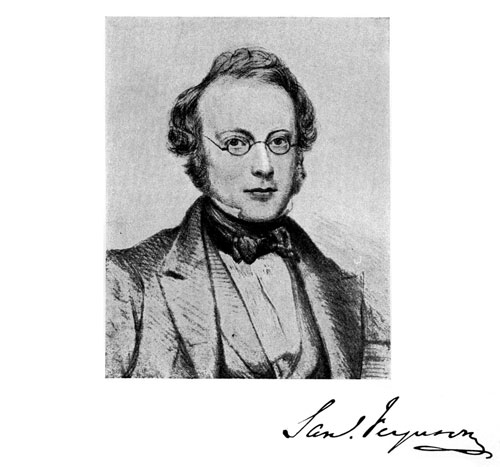
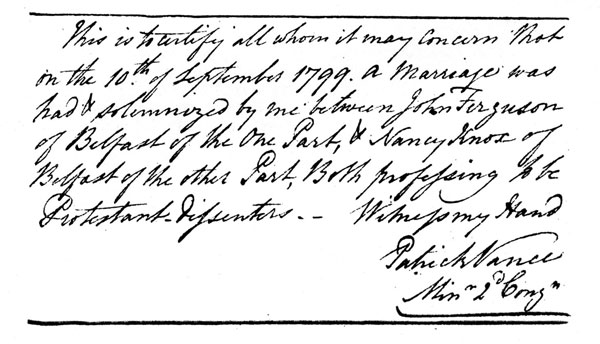
Lady Ferguson says in the Life of her husband :--
"Samuel Ferguson, youngest child of John Ferguson and his wife, Agnes, was born in Belfast on the 10th of March, 1810, in the house of his maternal grandparents in High Street."
Among the many distinguished names associated with the Second Congregation, none, perhaps, is more widely known than that of Sir Samuel Ferguson, Poet and Antiquary. His father and mother were married by the Rev. Patrick Vance, on 10th September, 1799, "both professing to be Protestant Dissenters" ; and their youngest child was baptised by the Rev. Wm. Hamilton Drummond on March, 1810. The day of the month and the name of the child are absent from the Baptismal Register; but, as the entry appears between the 11th and 29th March, there can be little doubt that it refers to the baptism of Sir Samuel Ferguson.
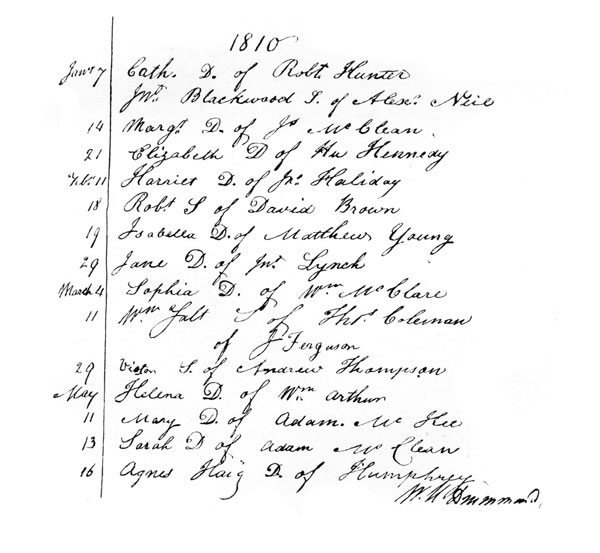
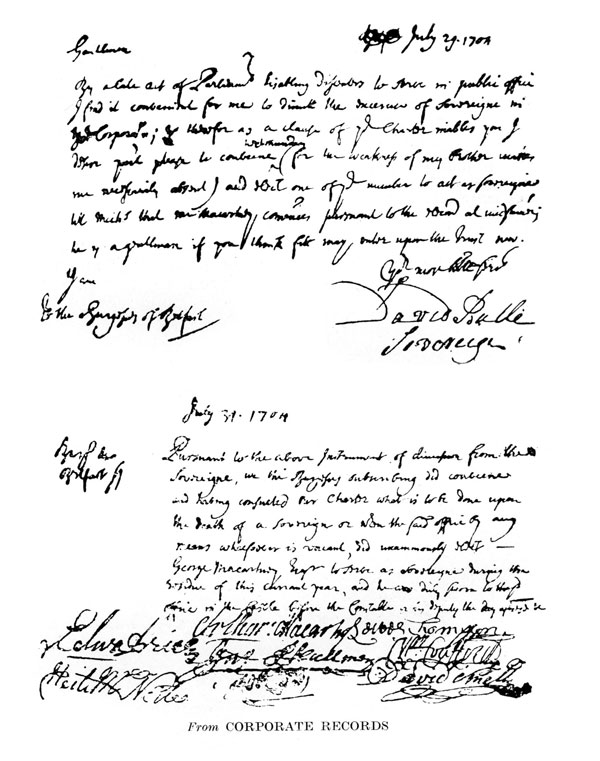
July 29, 1704.
Gentlemen,
By a late Act of Parliament disabling disentors to serve in public office I find it convenient for me to dimett the exercise of Sovreigne in yor Corporatn; & therfor as a clause of yor Charter inables you I desire you'l please to convene next Thursday (for the weakness of my brother makes me necessarily absent) and elect one of yor number to act as Sovreigne till Michs that Mr. Macartney commences pursuant to the elecion at midsumer, he is a gentleman if you think fit may enter upon the trust now.
I am yor most hble servt
David Butle Sovereign
To the Burgesses of Belfast.
July 31, 1704
Burgus de Belfast
Pursuant to the above Instrument of dimession from the Sovreigne, we, the Burgesses subscribing, did convene and, having consulted our Charter what is to be done upon the death of a Sovreign or when the said office by any means whatsoever is vacant, did unanimously elect George Macartney Esqr as Sovreigne, during the residue of this current year, and he was duly sworn to the said office in the Castle before the Constable or his deputy the day aforesd
Arthur Macartny : Lewes Thompson : Edwa Brice : Jno Challmers : Wm Crafford : Neile McNeile : Robt Leathes : David Smith.
The page from the Corporate Record, reproduced on page 80, is a typical example of fiction versus fact, Benn gives a copy of Butle's letter of 29th July, 1704, Young gives a different version of the same letter in The Town Book of Belfast, pages 194-195, but substitutes the name Buller for Butle. Sir David Owen copies Young's version, with the name Buller. Who wrote the letter? Butle or Buller? In The Town Book of Belfast, page 243, there appears :--
"1703 and parte of 1704. David Buttle Burgesse was ellected and sworne (Soveraigne) for ye ycare ending Michallmas 1704 but surrendered the Rod the 29th of July 1704, by a late Act of Parliamt disabling dissenters to serve in publique office and succeded for ye remainder of that ycare by George Macartney Esqr Councellor at law."
The Town Book of Belfast seems to have been copied from the Corporate Records by two amanuenses, one of whom transcribed the name as Buller and the other as Buttle, without the editor detecting the error. In the Index there appears :-- "Buller, David, Sovereign, 193-195." As a matter of fact no one of the name of Buller was ever Sovereign of Belfast, although James Buller was a Burgess. He was a tanner by trade; elected a Burgess on 26th February, 1689 ; and his successor was elected on 6th February, 1702, "in the place & room of James Buller Burgesse deceased".
The mistakes of Young and Owen are all the more remarkable because Benn says in his 1877 History :-- "David Buttle, or Butle, as he himself spells his name, was a Belfast merchant." (Page 565.)
In addition to being a Belfast merchant, David Butle was a staunch Presbyterian. After the passing of An Act to Prevent the Further Growth of Popery, the following Petition, dated 14th March, 1704, was presented to the Irish Parliament :--
"Your Petitioners crave leave to represent to your Honours that when the Bill entitled An Act to Prevent the Further Growth of Popery was returned from England, your Petitioners (to their great surprise and discouragement) found a clause inserted therein which had not its rise in this honourable House, whereby they were disabled from executing any public Trust for the service of her Majesty, the Protestant religion, and their country (tho' as willing and ready to do the same as ever) unless, contrary to their conscience, they shou'd receive the Sacrament of the Lord's Supper, according to the rites and usages of the Establish'd Church."
Among the signatories was David Butle, Sovereign of Belfast, He continued his office of Burgess till he was ruthlessly expelled from the Corporation by a majority of 65 votes to 53 of the Irish House of Commons, 28th October, 1708.
Thus by a majority of 12 votes out of 118 members present, five Burgesses -- William Craford, John Chalmers, David Butle, Edward Brice, and Neile McNeile -- paid the penalty of their conscientious convictions, by being expelled from a Corporation which they had served honourably ; and their places were filled by others "which said Burgesses have qualified themselves according to ye late Act of Parliament against the growth of Popery". There was, however, one pleasing incident. Nicholas Thetford was chosen a Burgess in place of William Craford, but to his honour be it recorded, Thetford refused "a Burgess ship coming in such a manner". Three years later he was elected in place of Lewis Thompson, deceased.
As a member of the Rev. John McBride's Congregation, Butle took an active part in the erection of the Second Congregation, of which he became an original member, under the ministry of Rev. James Kirkpatrick, D.D., M.D. In An Historical Essay upon the Loyalty of Presbyterians the name of David Butle is appended to A Vindication of the 'late Burgeses of the Corporation of Belfast,' dated 2nd September, 1713. He died in the following year and was buried on Christmas Day, 1714.
